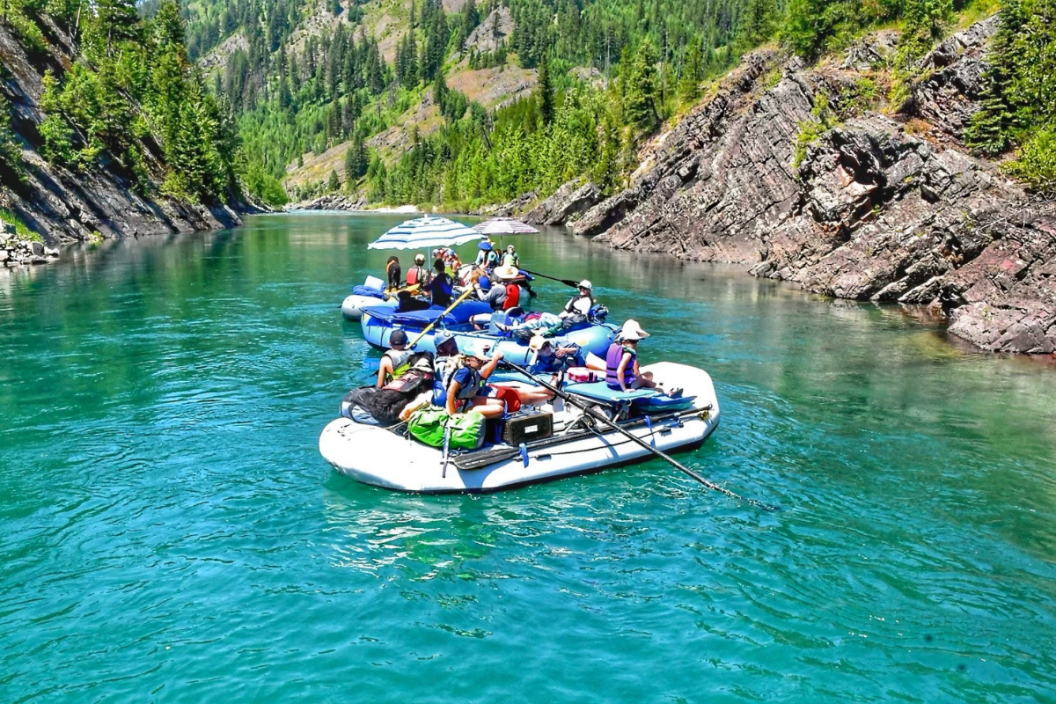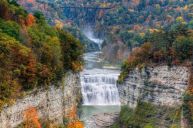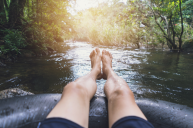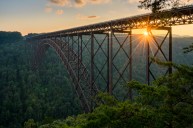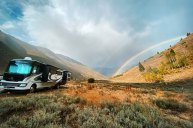The American landscape is shaped by water. Rivers run in patterns like veins on a leaf; streams so small you can walk across join to form creeks, and creeks join to form small rivers. Rivers merge to form the iconic waterways of the Colorado River in the Grand Canyon or the mighty Mississippi. When road tripping, the route will often follow a river's circuitous path of least resistance through the country. We'll catch a glimpse of a beautiful river as we pass high overhead on a bridge. Well, I promise you, you'll see some incredible sights and have a lot more fun if you stop staring out the window and passing rivers by and get out on the water!
As the daughter of a Montana river guide and someone who spends most summer weekends rafting the Flathead, I know that there is no better way to see the path less traveled than taking a river rafting trip. Speak with any river guide, and they will tell you that a river trip leaves a lasting impression on a traveler in a way many other experiences can't. Something magical about how a river trip can change your perspective and show you things you'd never otherwise see. I love how it simultaneously challenges and excites you yet still fosters a sense of calm and "go with the flow."
River rafting can be a design-your-own-adventure if you have the skills and the gear, but the best way is to book a trip with a guide who knows the water. When many people hear 'rafting,' they think of whitewater rafting or even extreme whitewater in the Grand Canyon. But what many folks don't know is that there are rafting adventures for anyone, no matter your experience level or tolerance for adrenalin. And so many rivers to choose from! This guide will give you an overview of rafting trips in America and help you book the right raft trip for you, whether it's your first or tenth raft trip.
Is River Rafting for You?
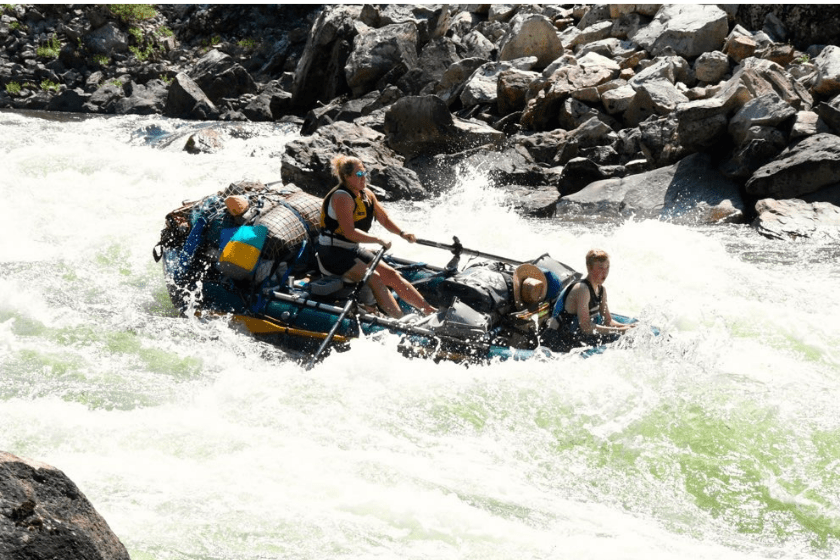
Rachel Schmidt
If you're a thrill-seeker, there are many rivers in all areas of the country where you whitewater raft through churning rapids and eddies. Rapids are measured on a scale of I-VI, based on how big a rapid's waves are and how difficult it is to run. According to American Whitewater, a Class I rapid is fast-moving water with riffles and small waves. At the other end of the spectrum, Class VI rapids are extreme, perilous, and should seldom be attempted. The majority of family-friendly whitewater is rated II - III. However, a rapid's rating does not tell the whole story, as the volume of water in a river can make a massive difference in the experience of running a rapid. High flows can turn a rapid into a monster, and low flows can make it gentle. But always remember the class of a rapid does not dictate how much fun you will have—bigger isn't always better, and a class IV does not mean you will have more fun than a class II.
Those who are more interested in seeing the country, views, wildlife, and just simply floating look for what is usually billed as a 'scenic raft trip.' These are sections of rivers with minimal rapids, letting you merely enjoy the float.
It's no fun being scared out of your mind on a supposedly chill float. Neither is being stuck on a slow, calm float when you were looking for a thrill ride. Even though booking trips online is standard procedure for travelers these days, I highly recommend you call and speak with the outfitter before booking a rafting trip. Be clear about what you want. Scenic float? Family-friendly whitewater? An epic adventure? If whitewater is essential, ask about the typical river flows for when you're doing your trip and how that impacts their trips.
How Far Do You Want to Raft?
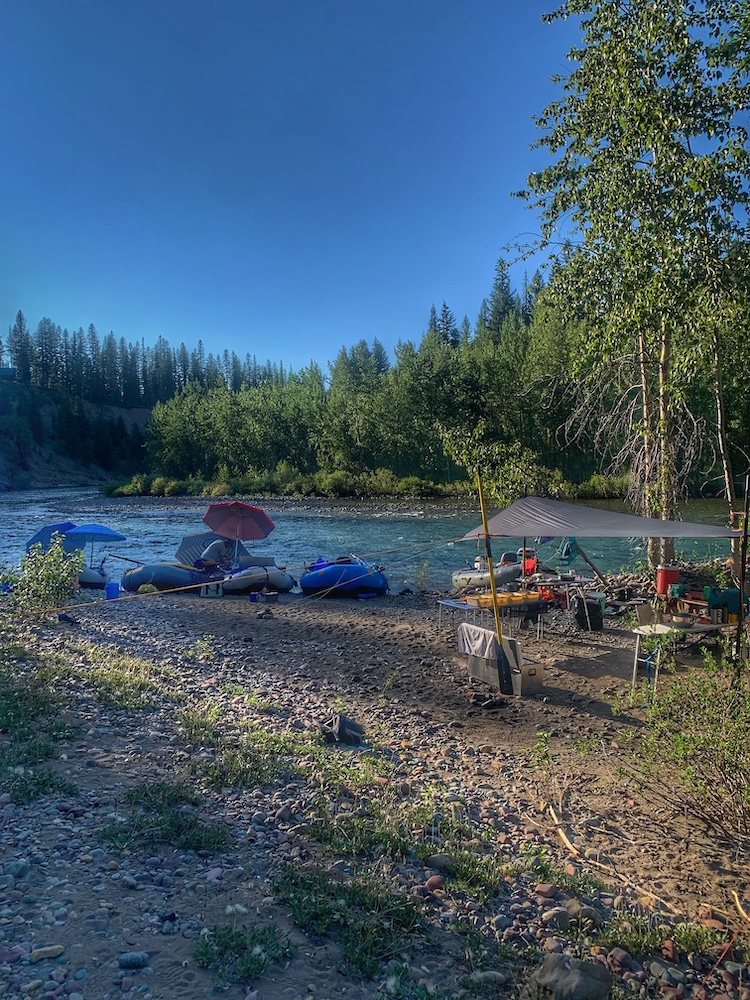
Rachel Schmidt
RELATED: Grand Canyon Camping is the Best Adventure You Haven't Taken
Figuring out how much of the river you want to experience is just as important as choosing the right type of rafting trip. Typically you can book half-day whitewater or scenic floats, full-day combinations, or multi-day trips.
Half-day trips are usually 3-4 hours in length. A full day is usually 5-7 hours and almost always includes a riverside meal packed in the boat with you and eaten on the side of the river. Sometimes your meal is transported to the river and prepared for you at a particular spot along your journey. No matter how long of a trip, you will be driven on a shuttle to the "put-in," the place of river access where you start your trip. You will end at the take-out, where another shuttle vehicle will pick you up and take you back to the raft company's headquarters. Unlike 'river rides' at amusement parks, you will not start and stop at the same place. Natural, free-flowing rivers do not flow in a circle; you will always be floating down river when rafting.
If you have the time to experience a multi-day raft trip, it can be a true bucket-list experience. For a multi-day trip, the professional river guides pack all you need in dry bags and rafting-specific pack boxes in the boat with your group. You camp on the side of the river, enjoy lovely food while sitting around a campfire, and experience parts of the world that few ever do. You need to know that there are usually no formal restroom facilities on these trips; at best, you will be in an outhouse situation. More likely, you will use a self-contained toilet system that is also packed in the raft and set up behind cover on the river's shore.
This is nothing to be afraid of or avoid (hey, we all do it). You just need to familiarize yourself, so you know what to expect. The best way to get a feel for what a multi-day trip looks like on or off the river is to check out companies' websites that make the gear. Have a look at NRS and Eddy Epics 2.0.
Book a Raft Trip with Professionals
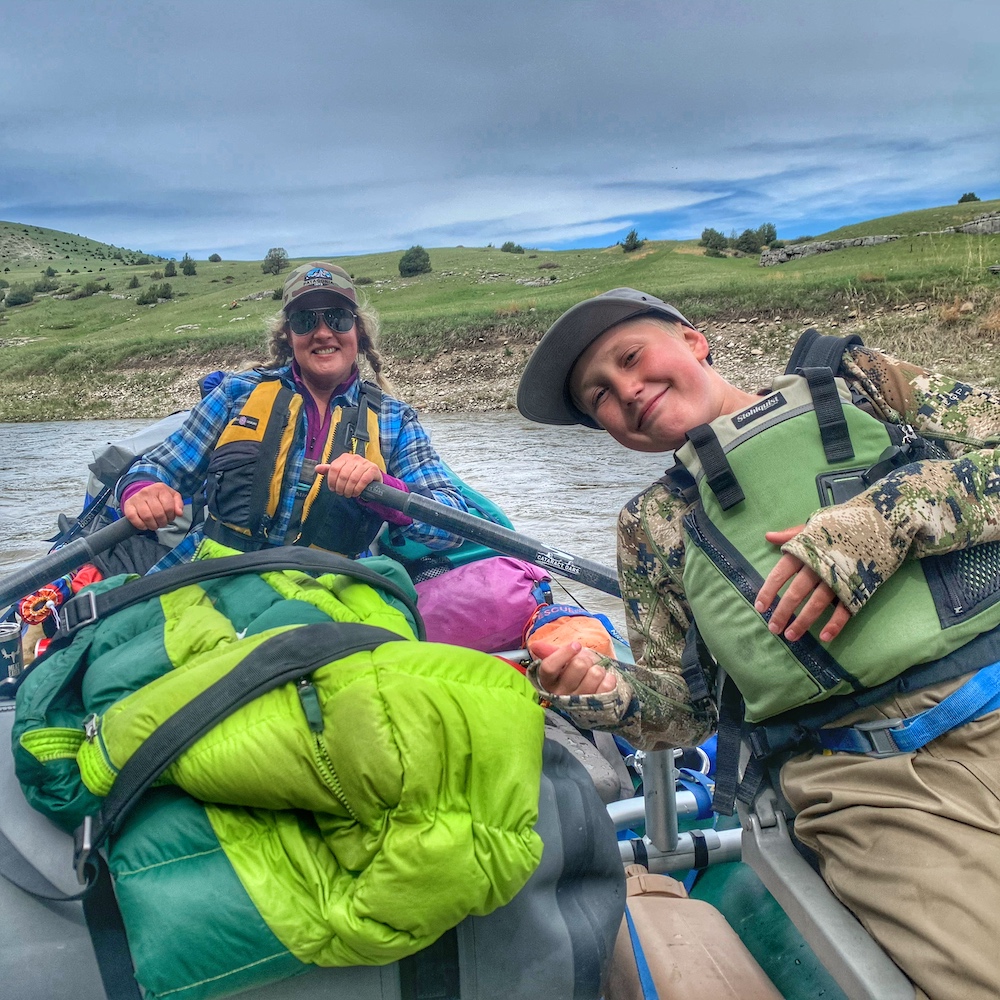
Rachel Schmidt
Rafting trips are run by licensed guides and state-endorsed outfitters. When booking a trip, it is improbable in North America that you will run into fraudulent, unlicensed services. Still, you can always ask to verify their credentials. Unless you have significant river-running experience, booking a self-guided trip is not a good idea. This type of trip is basically a raft rental with acceptable use on a specific section of a river. Book a fully guided trip.
However, just because you've booked a guide doesn't mean that you won't be doing some of the work. There are two types of raft setups: oar rigs and paddle boats. An oar rig has you sitting in the boat, either front or back, and the guide is in the middle steering the boat with two large oars. A paddleboat positions all the passengers on the boat's sides, each with an oar to provide the power and a guide in the back steering with a paddle or rear oar mount. There is a hybrid called a paddle assist; this is an oar rig with paddlers on each side, front and back. This is mainly used on more extreme rivers and is not common.
Before You Book, Some Pro Tips
- Book a suitable trip for the person in your group who is most apprehensive about the experience. For example, if you have a child or adult who is significantly afraid of trying whitewater, make sure you book a trip for your whole group to alleviate this fear. If you book an aggressive whitewater trip in this situation, you make a miserable trip for the person with apprehension. It impacts everyone on the boat.
- Most day trips and some multi-day trips combine multiple groups in a boat. If you are looking for something exclusive for your group only, you must request it, which will likely have an additional cost.
- Pricing is usually based on per person per day trip or per person per day for multi-day trips. Make sure to clarify, so you understand pricing. And the saying 'you get what you pay for' applies here as well; price shopping between companies in a specific area for the lowest price is not always the answer.
- Depending on the river and the level any given river is running at the time, there most likely will be age restrictions. Ask for details if you have young children or the elderly in your group.
- If you enjoy your ride, tip your guide! 10-20% is average.
- For a list of reputable outfitters across the country, check out America Outdoors Association.
What Is a Wild and Scenic River?
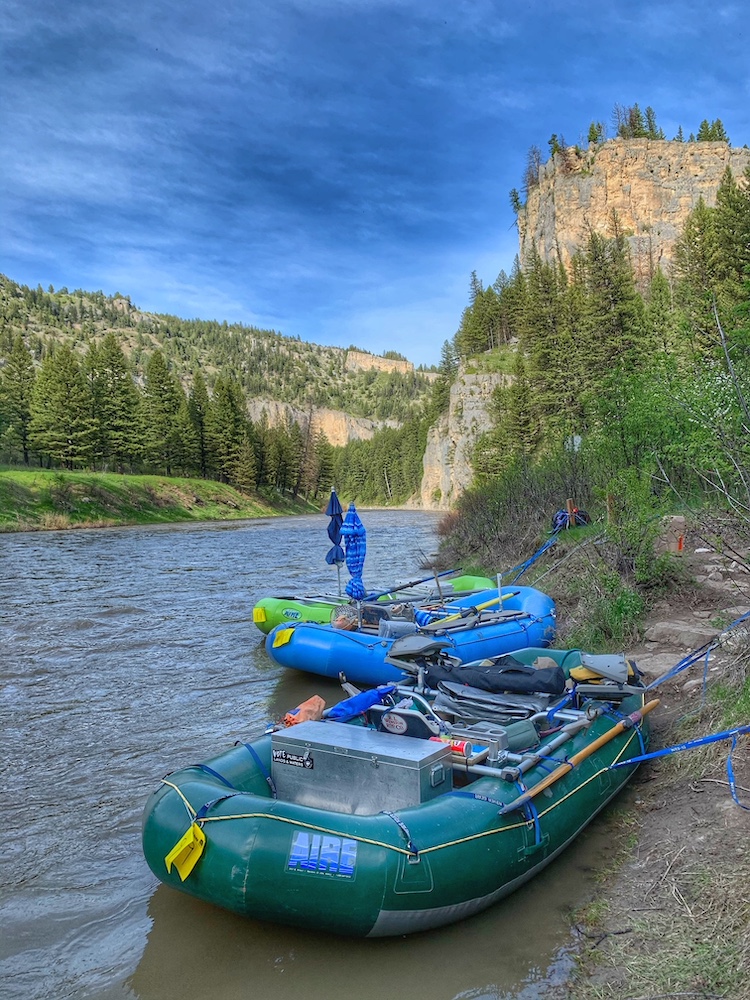
Rachel Schmidt
According to National Wild and Scenic Rivers, "The National Wild and Scenic Rivers System was created by Congress in 1968 to preserve certain rivers with outstanding natural, cultural, and recreational values in a free-flowing condition for the enjoyment of present and future generations. The Act is notable for safeguarding the special character of these rivers while also recognizing the potential for their appropriate use and development."
There are 3 classifications of a river:
- Wild- rivers or sections of rivers that are free of impoundments and generally inaccessible except by trail, with watersheds or shorelines essentially primitive and waters unpolluted
- Scenic- rivers or sections of rivers that are free of impoundments, with shorelines or watersheds still essentially primitive and shorelines largely undeveloped but accessible in places by roads
- Recreation- rivers or sections of rivers that are readily accessible by road or railroad that may have some development along their shorelines and that may have undergone some impoundment or diversion in the past.
Check out a map of these rivers and make plans to visit as many as possible. Examples of outfitters that provide experience on the Flathead Wild & Scenic River System are Glacier Raft Co. and Montana Wilderness Lodge & Outfitting.
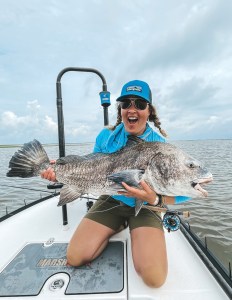
Though embedded like a tick in her hometown of Whitefish, Montana, Rachel Schmidt has spent her life adventuring across the continent. Her career spans a spectrum of the recreation industry and conservation work with a pitstop for a term as the Directory of the Montana Governor's Office of Outdoor Recreation. Most of the time she's fly fishing, camping, hunting, skiing, rafting, boating, drinking whiskey and/or chasing her two teenage sons and Hal-the-bird-dog. Instagram @mtraerae.
What do you love about rafting? Share with us on our Wide Open Roads Facebook!
